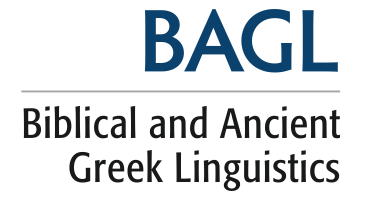Biblical and Ancient Greek Linguistics (BAGL)
Biblical and Ancient Greek Linguistics (BAGL) is an international journal that exists to further the application of modern linguistics to the study of Ancient and Biblical Greek, with a particular focus on the analysis of texts, including but not restricted to the Greek New Testament.
The journal is hosted by McMaster Divinity College and works in conjunction with its Centre for Biblical Linguistics, Translation and Exegesis, and the OpenText.org organization (www.opentext.org) in the hosting of conferences and symposia open to scholars and students working in Greek linguistics who are interested in contributing to advancing the discussion and methods of the field of research. BAGL is a refereed on-line and print journal dedicated to distributing the results of significant research in the area of linguistic theory and application to biblical and ancient Greek, and is open to all scholars, not just those connected to the Centre and the OpenText.org project.Areas of Research of Interest to BAGL
The following list provides an indication of some of the open questions for research that are currently being investigated or are of interest to the journal, as well as those connected with the Centre for Biblical Linguistics, Translation and Exegesis, and the OpenText.org project (www.opentext.org). These include:
- a Systemic-Functional analysis of voice in ancient Greek
- developing a discourse grammar of conjunctions
- the identification and functional classification of the paragraph as a unit in Greek discourse
- the identification and functional analysis of discourse units intermediate to clause complexes and the text
- discontinuous constituents in Greek syntax
- the quantitative and qualitative analysis of register
- the morphology, grammar and discourse function of the vocative case
- significant discourse analyses of books of the New Testament and of the Septuagint
- thematization and word order in ancient Greek
- issues and problems in discourse analysis of ancient Greek
- lexicography in the light of semantic domain theory
- various theories of syntax
- levels of linguistic analysis including word group, clause component, clause structure, clause complex, and paragraph
- the challenges of corpus linguistics related to the study of ancient Greek
- the problems of the case and voice systems
- textual encoding and analysis
- functional hermeneutical models
Volume 1 (2012)Show table of contents
See the full List of Open Access Journals in Ancient Studies
